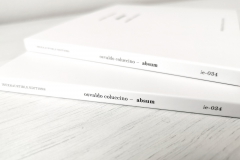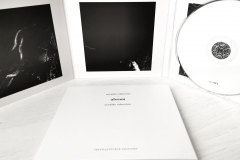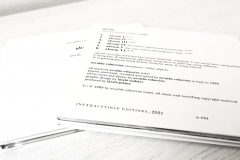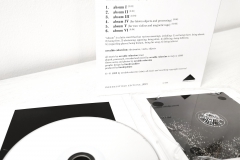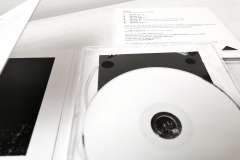Osvaldo Coluccino – Absum
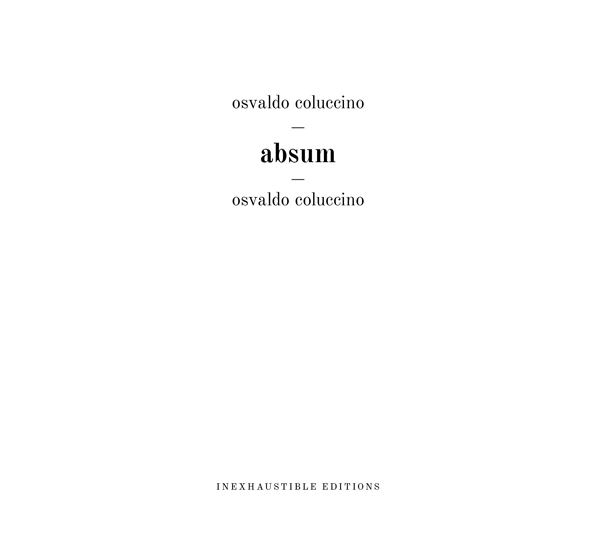
1. Absum I (3:19)
2. Absum II (5:51)
3. Absum III (4:04)
4. Absum IV (for blown objects and processing) (9:06)
5. Absum V (for two violins and magnetic tape) (10:35)
6. Absum VI (9:34)
“Absum” is a Latin word that has various meanings, including: 1) not being there, being absent, 2) being free, 3) abstaining, opposing, being alien, 4) differing, being different, 5) (regarding places) being distant, being far away, 6) being inferior.
· Osvaldo Coluccino: electronics, violin, objects
All music by Osvaldo Coluccino (SIAE)
Played, processed, recorded and mixed by Osvaldo Coluccino in Italy in 1999
Sleeve notes and photos by Osvaldo Coluccino
Graphic design by László Szakács
Produced by László Juhász
©+℗ 1999 Osvaldo Coluccino (SIAE), all music and recording copyright reserved
Presence of the work, absence of the author
So muffled, vapor escaping from an old coffer, so dusty and apparently, in some ways, timbrically “primordial” and yet elusive, the first three compositions of the album unfold. The following three increase the dynamism and openness of the timbre.
As always in my albums, also in Absum a journey takes place along the tracks that, joined together, make it up.
Even in this “raw” timbre paste, emblem of adherence to the roughness of life (or death), there is multiplicity and mutability: the carpet is perturbed by rivulets of inserts, wave shifts and degrees of spatial depth. The first three pieces have a more intimate, dark, slow, melancholy character; Absum IV presents asymmetrical weaves and movements mainly generated by altered puffs and airy doughs in three-dimensionality; Absum V bewitches us with metamorphic mixtures in space created by two violins that expressively and ineffably “sing” at the two opposite wings of the hall and in the distance, and by the related processings; Absum VI would seem a development of what was previously sown, it expresses a wealth of intent and then takes leave with a whirlwind closure, as if it were the final movement of a symphonic composition in which the themes or, as in our case, the stylistic elements, return, but in a fragmented way, mix each other, and then close the work in a dizzying way.
In the prevailing harmonic indeterminacy, or along this texture of the noise, it is also possible to detect a couple of “interference” according to traditional harmony, eg. in the opening of Absum II an interval of perfect fourth appears (B flat-E flat), and in the closing a repeated descending minor third (D flat-B flat). This same last interval (minor third) is repeated, but ascending, at the end of Absum III. Obviously this should not be interpreted as a retrograde (wink to the tonality) or manneristic event, but on the contrary as an emotional necessity.
“Absum”, a Latin word that would mean: “despite all this, the self has nothing to do with it”, “the self has ‘gone out’ for a moment”, “there is something else that is more entitled to attend or to stay than the self“… As if to say, aiming for a sort of resistance to the centrality (arrogance) of the author and, consequently, for a certain ontological dissipation… in favor of the work itself.
It is an album that had its gestation in the mid-90s of the last century, then not so distant, in terms of aesthetics, from a certain charm of “early electronic” nor many years away from some rare high-profile electroacoustic research by classical composers in the mid-1980s. Two conservatory students, in the course of Analysis of Electroacoustic Music taught by Maestro Antonio Doro, in 2005 presented their diploma thesis on two of Absum‘s pieces.
Osvaldo Coluccino
Released: March 2021 / first edition of 300 cds
Direct purchase: Bandcamp / Discogs
GALLERY ↓
REVIEWS ↓
“A man and composer of uncommon sensibility in an Italian scene depressingly founded on the terminal cancers of political alliances and rampant falsehood, Osvaldo Coluccino gets straight to the point when he talks about Absum, published some 22 years after its conception.
‘The premise is (…) the hope that the work, in its purity, speaks for itself and of something that concerns what goes beyond, making use of the artist (the human being) as a sounding board, but limiting his presence as much as possible – that is, his exhibitionism and virtuosity, his existential supremacy over the instances of art.’
For context, please read the complete interview.
The Latin word ‘absum’ is indeed the root of ‘absent’. Those accustomed to reasoning in terms of ‘maestro’, ‘conductor’, ‘harmonic laws’ and whatnot might perceive a record like this as anathema. Only the universe’s main component – the sound – is present in variously altered/processed forms. The one who turned it all on is, in this case, practically invisible, though we can distinctly feel his spirit behind the whole.
We ought to be grateful for these six movements, at once representing a valuable teaching and, in the opinion of this reviewer, a sizable sample of Coluccino’s finest artistry.
The following are personal sensations jotted down track by track, over a cycle of listening sessions. By definition, they are extremely limited as far as the capacity of attributing the correct connotations to such an intangible inwardness is concerned.
1) Trembling electronic frequencies, almost shy in their manifestation, yet rich in subsonics substantiating their effect on our perception.
2) My overall favorite part. The music breathes, touches deep inside, unravels between distant murmurs containing harmonic embryos and more vivid manifestations. Noisy apparitions immediately vanish in the dark, or transmit signals that cannot be decoded via normal analytical processes. Awesome ghostly resonances place the listener in a transcendent meeting of pasts never really identifiable. There are faint lights in the apparent decline of shapes. The instinctive attraction to them must be trusted.
3) Coluccino is here at his highest level of ‘galactically insightful’, so to speak. The slowing down of the vital pulsations broadens the inner visual field, at the same time subtracting a little anxiety from the set of reverberating auras. We’re aware of having now reached the centre of a psycho-mnemonic cage, built by no one.
4) The concreteness, however seemingly ethereal, of the composer’s insufflations through unspecified objects and instruments adds a dramatic dimension of sudden awakening. In between, quasi-carillonesque cues and unexpected eruptions from nowhere, at times of metallic descent, create a sequence of psychoacoustic frames that conceal rather than reveal. Still, the truth is, to some extent, intuitable. The most profound ‘why?’ should ideally remain unanswered, until the next stage of evolution.
5) Coluccino superimposes two violins, both played by him, with a magnetic tape of electroacoustic ectoplasms. The result is a kind of abstractionism that, nevertheless, possesses several figurative attributes. We detect the struggle of the ephemeral earthly vessel to stay afloat amidst a thousand doubts of diverse origin. The mind, potentially corruptible by stupidly esoteric formulas, finds itself facing what is wonderfully pure, which in turn would be described by the ignorant as ‘dangerous’. Or, at least, misleading. But this, like it or not, is the right path to follow.
6) We are not granted the commonplace of ‘well-deserved rest’ at the end of the journey. The concluding movement is a reminder of what is harsh, uncomfortable, unclassifiable for one’s own convenience. More abrupt cuts, silences as long as a freeze-dried eternity, openings on interpretations of a vibratory future that won’t take into consideration the selfishly intellectual needs of mere human beings. For they continue to believe in fairy tales narrating an anthropocentric trip towards the demise of intelligence.” / Massimo Ricci, Touching Extremes, 31 May 2021
“Osvaldo Coluccino è un poeta e compositore che merita un’attenzione particolare. Se cerchiamo giustificazioni sull’utilità delle rappresentazioni nel campo dell’arte non possiamo fare a meno di andare alla ricerca di significativi indizi sul buon equilibrio delle nostre coscienze: la poetica di Coluccino scava proprio in quell’incavo di analisi, tipico del Novecento, che ha riflettuto a fondo sul valore dell’esistenza. Rapito dalle parole e dalla pittura di gente come Jacques Lacan o Francis Bacon, Coluccino ha costruito un proprio percorso nel momento in cui il mondo ha cominciato ad abbandonare la ricerca interiore e l’interrogazione dell’animo per trovare conforto nella filosofia, quando quest’ultima nel frattempo stava diventando anch’essa evanescente. La comprensione dei propri istinti e l’inquietudine sopraffatte da un becero risvolto speculativo.
La maturità di Coluccino si è da sempre espressa seguendo due binari, uno classico e strumentale, l’altro elettroacustico e climatico; quanto al primo, il compositore ha imposto una musica dal carattere solo a lui ascrivibile, ossia una rappresentazione dettagliata del “fioco”, qualità che su queste pagine ho avuto modo di descrivere tramite i suoi cds per Kairos soprattutto; quanto al secondo, Coluccino si è invece inventato un canale di ricerca e manipolazione dei suoni che è essenzialmente sforzo mentale sulla percezione. In entrambi i casi risalta un pensiero ben determinato, ciò che Coluccino ha definito “emissione sonora minima”, ossia divaricazioni delle distanze dei suoni, dettagli e colorazioni sonore che cercano di andare oltre l’ascolto, di fornire subdola materia mentale ed immaginativa utile per carpire tensioni e concetti che non sono affatto visibili, perché si ottengono dalle vibrazioni di suoni o di versi.
Osvaldo ha appena pubblicato un altro cd di musica elettroacustica, dal titolo absum, parola latina a cui il compositore non dà certamente un significato univoco, quello della prassi comunicativa: non è solo assenza fisica o intellettuale quella di cui si tratta, ma è necessario anche porre significati conseguenti, come opposizione, differenza, inferiorità. C’è un evidente radice lacaniana in questo, soprattutto quando si pensa alla “presenza-assenza” del suo A Father, ma c’è anche un’estensione verso una muta concezione di elementi che hanno un proprio spazio d’azione: come nel concept di Oltreorme, Coluccino è alla caccia di quel mondo interiore sprigionato oltre le note o i suoni, allo stesso modo con cui un pittore cerca di fare attraverso un suo dipinto (vedi le mie considerazioni qui).
absum contiene registrazioni del 1999 in un ciclo di 6 episodi musicali, in un periodo particolarmente fecondo di creatività dell’autore sul versante dell’elettronica e della manipolazione, qualcosa che tutti gli appassionati di musica hanno avuto già modo di apprezzare splendidamente nei risultati di un cd per Die Schachtel dal titolo Dimensioni (composizioni scritte tra il 1997 e il 2007, dove Osvaldo ha probabilmente raggiunto il suo picco massimo). absum ha dentro le sensazioni di quel periodo, quando la progettualità si indirizzava con un infinito garbo e profondità di visuale a temi e sistemi già conosciuti nella storica elettronica italiana (Nono, Maderna, Berio, etc.), tuttavia le operazioni di Coluccino hanno un proprio stile, qualcosa che l’immaginazione dell’ascolto restituisce come un patchwork composito, con distillazione dei suoni, evidenziazione delle prospettive e delle dinamiche, con odissee semi-silenziose e, nella mia mente perversa (stimolata anche dalle parole di Osvaldo) persino evoluzioni sonore del vapore, sbuffi e risalite di una caffettiera.
Le provvidenze tecniche di absum sono perfettamente descritte nelle note interne da Coluccino, che ci porta a conoscenza anche di una tesi di studenti del Conservatorio basata sulle 6 tracce, anche se temo che sarà praticamente impossibile per gli ascoltatori riconoscere lo strumento del violino da lui suonato o gli oggetti utilizzati in alcune delle tracce, data la trasformazione impressa.
Il fatto è che absum dimostra non solo che Coluccino è un abilissimo manipolatore di suoni con un amore per la sapienza e le confutazioni dell’animo, ma anche che è necessaria una riflessione sull’elettronica odierna, costantemente alla ricerca di espansioni spesso aggressive o grossolane: forse invece di trovare “minacce” rappresentative dei tempi non sarebbe meglio andare alla ricerca di pazienti “risorse”?” / Ettore Garzia, Percorsi Musicali, 20 August 2021
“Materiali d’archivio risalenti al 1999, quindi vecchi di ben vent’anni, vedono oggi la luce del sole per merito del marchio sloveno Inexhaustible Editions. Questo è il leitmotiv dell’ultimissimo disco firmato da Osvaldo Coluccino. Come specificato nel sottotitolo si tratta di composizioni elettroacustiche, un ambito nel quale l’autore si era già distinto con pubblicazioni su Die Schachtel, Another Timbre e Unfathomless. Trattamenti e sonorità elettroniche, oggetti da far risuonare soffiandoci (in Absum IV), due violini (in Absum V), questo è l’armamentario utilizzato nelle sei composizioni. L’autore spiega in un inciso che Absum è un termine latino dai vari significati, tra i quali essere assente, essere liberi, essere estranei, essere diversi, essere inferiori, essere distanti (in caso di luogo) … I concetti di libertà, estraneità e diversità mi sembrano i più attinenti alla definizione di queste musiche un po’ aliene, a tratti oscure, timbricamente metalliche, colonna sonora perfettamente adattabile allo scenario di un pianeta deserto e inesplorato come a quello di un plesso industriale abbandonato. Suoni futuribili in grado di evocare stati d’angoscia. Chi già conosce l’universo sonoro di Coluccino lo ritroverà qui nei suoi aspetti più inquietamente visionari.” / Mario Biserni, Sound And Silence, 21 October 2021
“This is a very smart package from Inexhaustible Editions, with six tracks accompanied by liner notes from Osvaldo Coluccino. These notes threw me; I’ve heard some of Coluccino’s work before, on the excellent Another Timbre label, and it was very ‘soundy’ – as in, focussed on timbre and texture; here, though, Absum’s notes analyse and introduce the piece in very musical terms, discussing notes and chords. The release is in fact an electroacoustic piece composed, performed, and recorded by Coluccino in 1999.
So, rather than the micro-sound approach I had previously heard, Absum often deals with larger swathes of sound, drones and events. The pieces are born of manipulated ‘electronics, violin, [and] objects’ which are heavily processed to produce electronic tones and details – nothing someone versed in electroacoustics won’t have heard before, but still very engaging.
The album begins with Absum I, a short track of creeping, bass heavy drones that move around the stereo field, shifting and breathing. Absum II is more active but maintains a dark sense of dread, with detailed fragments of sound dancing over a bed of airy drones. The third piece – yes, its titled Absum III – pushes these drones further, into a distinct ghostliness, complete with disembodied voices. Absum IV presents more movement and more energy, with a material quality that reminds me of some Parmegiani; whilst the eerie drones remain, they are backgrounded, and punctuated by kinetic jolts of sound and moments of silence. The fifth piece doesn’t evoke the same sense of tectonic upheaval that Absum IV does, but it’s still a more dynamic work compared to the opening of the album. Subtitled ‘(for two violins and magnetic tape)’, the violins are indeed prominent and recognisable elements, with Coluccino processing them into long spectral drones and modulating sounds. The final track, Absum VI, is at points the most condensed, or cluttered, piece on the album, with rattling objects colliding before transforming into stop/start arrangements of warped processing and electronics. It’s an effective close to Absum, summarising much of what has come before.
This is a good, solid album – though I say that as someone who isn’t remotely an expert on electroacoustic music. Sections of the release, with its dark and ghostly drones, would please dark ambient fans; at other points, Absum VI for example, Coluccino presents more hardboiled work, but due to the engaging nature of the sounds the album can be easily enjoyed without knowledge of musical theory etc. – this knowledge probably unlocks further dimensions of Absum but these ears aren’t that tutored. The whole album has a pleasing atmosphere that, whilst not overly dark or aggressive, is certainly not ‘light’ to my mind, and I think a lot of people into noise will find much to savour here.” / Martin P, Musique Machine, 4 December 2021
“Absum is the March 1, 2021 release from Italian composer and poet, Osvaldo Coluccino. The album was recorded in 1999 with Coluccino utilizing electronics, violin, and ‘objects’.
This is composed electronic and electroacoustic music of low volumes and copious use of reverb and panning. Although, tracks four and five, Absum IV (for blown objects and processing) and Absum V (for two violins and magnetic tape) use acoustic source material as described in their titles. The treatment of the acoustic material is such that it is not always recognizable as acoustic in origin; it is most often processed and blended homogenously with electronic sounds.
This is subtle and detailed atmospheric music; some might even categorize it as ambient. Because of the low volumes, particular timbres, and use of panning as a significant compositional element, it is best enjoyed through headphones.
The album grows in complexity from Absum I to Absum VI. The first three tracks are barely audible, low-frequency fog-like textures emerging from, and evaporating into, silences; sounding like field recordings from a dystopian, digital future. Tracks four and five continue this ambience but at higher frequencies and more noticeable activity, or development, thanks in large part to the introduction of the acoustic material. The final track continues the Absum qualities of ‘not being there, being absent, being distant, being far away, being alien’ but with a more tangible quality in the more complex timbres and the greater variety in activity/development.
This album is unusually organic and austere for composed electronic and electroacoustic music, where often there can be a focus on the technology, a twisting of the knobs, if you will, absent of a fully formed aesthetic. Here there is a concise sound world with an intense focus, requiring a similar attention from the listener. This isn’t driving music, or casual background music, this is listening music that requires effort to extract its abstract beauty.” / Ron Coulter, The Free Jazz Collective, 5 March 2022
RADIO PLAYS ↓
· Glasni Novi Svet at ARS – 3. Program Radia Slovenija, Ljubljana, 14 April 2021
· No Wave at Tilos Rádió, Budapest, 30 May 2021

